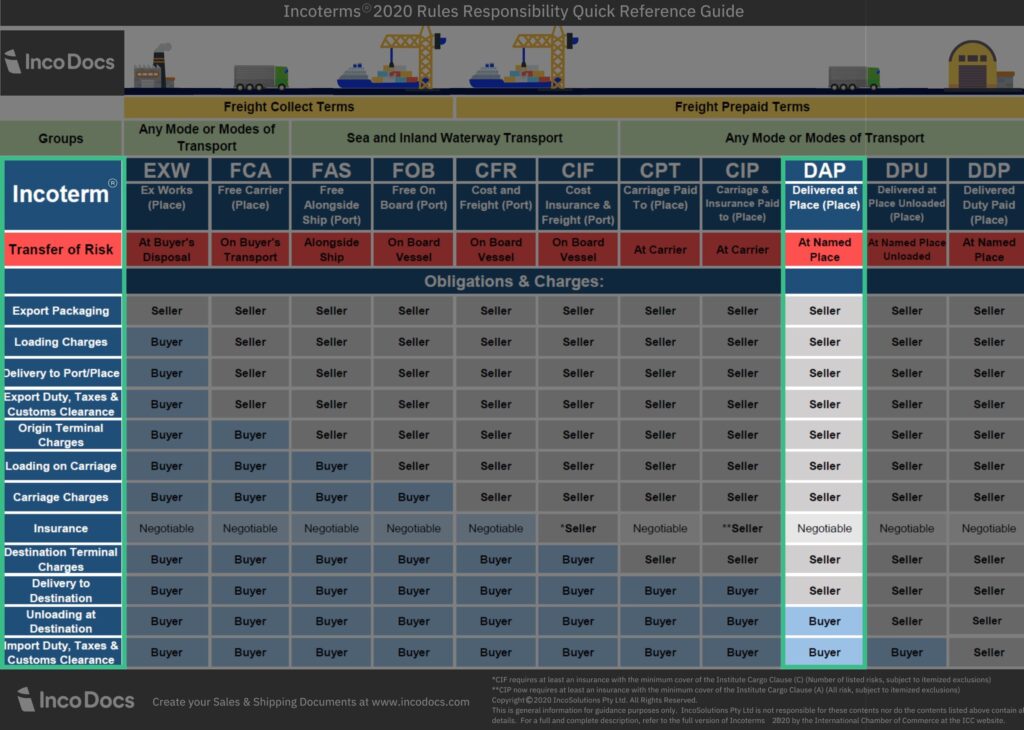International trade can be complex, with different expectations and potential obstacles. To help make things clearer, the International Chamber of Commerce (ICC) created Incoterms. These terms define the responsibilities of buyers and sellers in shipping. One important term is Delivered at Place (DAP). Knowing about DAP helps in handling shipments smoothly and managing the total cost of goods.
DAP replaced the older term DDU (Delivered Duty Unpaid) in 2020. This change provides clearer guidelines and better cost management for buyers.
What does DAP (Delivered at Place) mean in shipping terms?
DAP, or Delivered at Place, is a term used in international trade to define the responsibilities of the seller and the buyer during the shipping process. Under DAP, the seller is responsible for delivering the freight to a pre-agreed location, known as the named place. This location can be the buyer’s warehouse, a port terminal, or any other specified place.
The seller must handle all the logistics involved in getting the goods to this location. This includes export duties, transportation costs, and handling charges. The seller bears the risk of loss or damage until the goods are delivered to the agreed place of destination.
Once the goods arrive at the specified location, the responsibility shifts to the buyer. The buyer is responsible for unloading the goods, handling import clearance formalities, and paying any import duties and taxes.
In essence, DAP simplifies the process for the buyer by having the seller manage most of the shipping logistics and risks up to the delivery point. This term is particularly useful in ensuring that the buyer receives the goods at a location convenient to them, with the seller taking care of the journey until that point.
DAP Shipping Obligations for Buyer and Seller

Under the DAP Incoterm, both the buyer and the seller have specific obligations to ensure a smooth shipping process. Understanding these responsibilities is crucial for effective international trade.
| Seller’s Obligations | Buyer’s Obligations |
|---|---|
| Delivery to Agreed Place: Deliver goods to the specified location. | Unloading the Goods: Unload goods at the agreed place. |
| Transportation Costs: Cover all transportation costs up to the delivery point, including export duties and handling charges. | Import Duties and Taxes: Handle all import duties, taxes, and customs clearance charges. |
| Export Documentation: Provide necessary export documents and ensure compliance with export regulations. | Import Documentation: Provide necessary import documents and comply with local regulations. |
| Risk and Insurance: Bear all risks until the goods are delivered to the agreed place. Optional to insure the shipment. | Additional Transportation: Arrange and pay for any further transportation beyond the agreed place. |
Advantages and Disadvantages for the Buyer
Advantages
- Reduced Risk: Under DAP, the seller handles most of the transportation risks and costs. The buyer only takes on the risk once the goods reach the agreed place.
- Simplified Logistics: The seller manages the complex logistics of international shipping, making it easier for the buyer to receive goods without dealing with multiple carriers.
- Predictable Costs: The buyer knows the cost of the goods delivered to their location, making budgeting easier.
Disadvantages
- Higher Costs: DAP can be more expensive for the buyer compared to other Incoterms like FOB or CIF. The seller includes all transportation costs, which can increase the overall price.
- Customs Delays: The buyer is responsible for customs clearance and import duties. Any delays or issues at customs can lead to additional costs and delivery delays.
- Limited Control: The buyer has less control over the shipping process and may not have the opportunity to select the most cost-effective or reliable carriers.
- Unloading Responsibility: The buyer must arrange and pay for unloading the goods at the final destination, which can add to the cost and complexity.
Understanding these advantages and disadvantages helps buyers make informed decisions when choosing DAP as their shipping term.
DAP Insurance
Under DAP (Delivered at Place) Incoterms, insurance is not mandatory. However, it plays a crucial role in managing risks during transportation. Here’s what you need to know about DAP insurance:
Seller’s Insurance Responsibilities
- Optional Coverage: While not required, the seller may choose to insure the goods during transit. This protects against potential losses or damages up to the point of delivery.
- Risk Management: Since the seller bears the risk until the goods reach the agreed place, insuring the shipment can provide financial protection and peace of mind.
Buyer’s Insurance Considerations
- Post-Delivery Coverage: Once the goods are delivered to the specified location, the risk transfers to the buyer. It’s wise for the buyer to have insurance coverage from this point onwards, especially if further transportation is needed.
- Customs and Unloading: Any risks associated with customs clearance and unloading should be considered. Buyers may want to ensure their insurance covers these stages.
Importance of Clear Agreements
- Communication: Both parties should communicate clearly about insurance coverage to avoid gaps. Knowing who is responsible for insuring the goods at each stage helps prevent disputes and financial losses.
- Contract Details: Including insurance terms in the sales contract ensures both the buyer and seller understand their responsibilities and coverage limits.
In summary, while DAP does not require insurance, it is a valuable tool for managing risks. Both buyers and sellers should consider their risk exposure and decide on appropriate insurance coverage to protect their interests during the shipping process.
How Landed Cost is affected by DAP
Landed cost is the total cost of getting goods from the seller to the buyer’s location. Under DAP (Delivered at Place), the seller covers transportation, export duties, and handling charges until the goods reach the agreed location. This shifts many costs to the seller, potentially increasing the product price but making it less complicated to calculate total expenses as there is no transport charges up until the agreed upon delivery place. Typically the buyers final calculations will consist of, the DAP product price, import clearance, duties, taxes and unloading charges.
FAQ:
Who pays duty in DAP incoterm?
In DAP (Delivered at Place), the buyer is responsible for paying all import duties, taxes, and customs clearance charges once the goods arrive at the specified place of delivery. The seller covers all costs and risks up to the point of delivery, excluding import-related expenses.
What are the Obligations of DAP Incoterm?
Under DAP, the seller is responsible for transporting the goods to the agreed place, covering all associated costs and risks. The buyer is responsible for unloading the goods, paying import duties, taxes, and handling import clearance formalities. This division ensures clarity in responsibilities between both parties.
What is the difference in cost between DAP vs DDP?
The cost difference between DAP (Delivered at Place) and DDP (Delivered Duty Paid) depends on how responsibilities are divided. The more tasks the seller takes on, the higher the cost for the buyer. DAP is less expensive, covering transport but leaving duties and customs to the buyer, while DDP is costlier, as the seller handles everything, including import duties and customs clearance which is eventually passed onto the buyer. Read our comprehensive guide that compares DAP vs DPU vs DDP.







